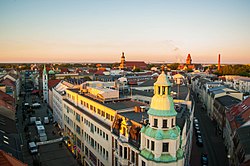List






The following table lists the 41 cities and communes in Brandenburg with a population of at least 15,000 on December 31, 2017, as estimated by the Federal Statistical Office of Germany. [2] A city is displayed in bold if it is a state or federal capital.
- The city rank by population as of December 31, 2017, as estimated by the Federal Statistical Office of German [2]
- The city name [2]
- The name of the district (Landkreis) in which the city lies (some cities are districts on their own called urban districts) [2]
- The city population as of December 31, 2017, as estimated by the Federal Statistical Office of Germany [2]
- The city population as of May 9, 2011, as enumerated by the 2011 European Union census [3]
- The city land area as of December 31, 2017 [2]
- The city population density as of December 31, 2017 (residents per unit of land area) [2]
| 2017 rank | City | District | 2017 estimate | 2011 census | 2017 land area | 2017 pop. density |
|---|---|---|---|---|---|---|
| 1 | Potsdam | urban district | 175,710 | 156,021 | 188 km2 | 933.3/km2 |
| 2 | Cottbus | urban district | 101,036 | 99,984 | 166 km2 | 610.0/km2 |
| 3 | Brandenburg an der Havel | urban district | 71,886 | 71,569 | 230 km2 | 312.9/km2 |
| 4 | Frankfurt (Oder) | urban district | 58,237 | 59,140 | 148 km2 | 393.9/km2 |
| 5 | Oranienburg | Oberhavel | 43,982 | 41,269 | 164 km2 | 268.7/km2 |
| 6 | Falkensee | Havelland (district) | 43,552 | 40,228 | 43.3 km2 | 1,007/km2 |
| 7 | Eberswalde | Barnim | 40,223 | 39,166 | 93.6 km2 | 429.5/km2 |
| 8 | Bernau bei Berlin | Barnim | 38,194 | 35,631 | 104 km2 | 366.7/km2 |
| 9 | Königs Wusterhausen | Dahme-Spreewald | 36,706 | 33,706 | 96.0 km2 | 382.2/km2 |
| 10 | Fürstenwalde | Oder-Spree | 32,098 | 30,913 | 70.7 km2 | 454.1/km2 |
| 11 | Neuruppin | Ostprignitz-Ruppin | 30,889 | 30,328 | 305 km2 | 101.2/km2 |
| 12 | Schwedt | Uckermark (district) | 30,075 | 31,785 | 206 km2 | 146.3/km2 |
| 13 | Blankenfelde-Mahlow | Teltow-Fläming | 27,378 | 25,503 | 55.2 km2 | 496.2/km2 |
| 14 | Strausberg | Märkisch-Oderland | 26,522 | 25,591 | 68.0 km2 | 390.3/km2 |
| 15 | Hennigsdorf | Oberhavel | 26,369 | 25,520 | 31.5 km2 | 837.9/km2 |
| 16 | Hohen Neuendorf | Oberhavel | 26,001 | 24,459 | 48.6 km2 | 535.4/km2 |
| 17 | Teltow | Potsdam-Mittelmark | 25,761 | 22,356 | 21.6 km2 | 1,193/km2 |
| 18 | Werder (Havel) | Potsdam-Mittelmark | 25,695 | 23,196 | 117 km2 | 219.5/km2 |
| 19 | Ludwigsfelde | Teltow-Fläming | 25,665 | 23,661 | 110 km2 | 233.4/km2 |
| 20 | Eisenhüttenstadt | Oder-Spree | 25,057 | 28,219 | 63.5 km2 | 394.8/km2 |
| 21 | Senftenberg | Oberspreewald-Lausitz | 24,558 | 25,582 | 128 km2 | 192.5/km2 |
| 22 | Rathenow | Havelland (district) | 24,309 | 24,462 | 113 km2 | 214.9/km2 |
| 23 | Wandlitz | Barnim | 22,585 | 20,615 | 163 km2 | 138.7/km2 |
| 24 | Spremberg | Spree-Neiße | 22,456 | 23,615 | 202 km2 | 111.0/km2 |
| 25 | Luckenwalde | Teltow-Fläming | 20,674 | 20,242 | 46.6 km2 | 443.6/km2 |
| 26 | Kleinmachnow | Potsdam-Mittelmark | 20,608 | 19,874 | 11.9 km2 | 1,730/km2 |
| 27 | Panketal | Barnim | 20,390 | 18,886 | 25.9 km2 | 788.8/km2 |
| 28 | Prenzlau | Uckermark (district) | 19,110 | 19,296 | 143 km2 | 133.7/km2 |
| 29 | Zossen | Teltow-Fläming | 18,915 | 17,267 | 180 km2 | 104.9/km2 |
| 30 | Forst (Lausitz) | Spree-Neiße | 18,353 | 19,757 | 111 km2 | 165.8/km2 |
| 31 | Neuenhagen bei Berlin | Märkisch-Oderland | 17,986 | 16,751 | 19.6 km2 | 917.2/km2 |
| 32 | Hoppegarten | Märkisch-Oderland | 17,966 | 16,628 | 32.0 km2 | 561.8/km2 |
| 33 | Nauen | Havelland (district) | 17,686 | 16,385 | 268 km2 | 66.0/km2 |
| 34 | Wittenberge | Prignitz | 17,201 | 17,792 | 50.6 km2 | 339.7/km2 |
| 35 | Guben | Spree-Neiße | 17,174 | 18,620 | 44.0 km2 | 390.4/km2 |
| 36 | Finsterwalde | Elbe-Elster | 16,409 | 16,970 | 77.2 km2 | 212.5/km2 |
| 37 | Lübbenau | Oberspreewald-Lausitz | 16,090 | 16,489 | 139 km2 | 115.4/km2 |
| 38 | Templin | Uckermark (district) | 15,974 | 16,237 | 379 km2 | 42.1/km2 |
| 39 | Rüdersdorf bei Berlin | Märkisch-Oderland | 15,569 | 14,922 | 70.4 km2 | 221.2/km2 |
| 40 | Stahnsdorf | Potsdam-Mittelmark | 15,270 | 14,031 | 49.5 km2 | 308.7/km2 |
| 41 | Petershagen-Eggersdorf | Märkisch-Oderland | 15,049 | 13,890 | 17.6 km2 | 853.6/km2 |
